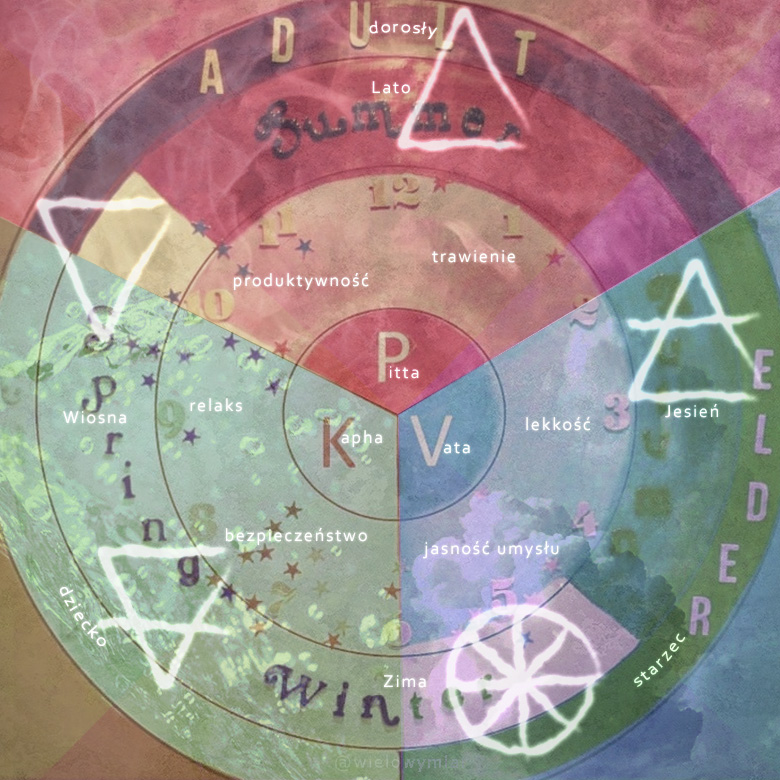I recommend starting from the beginning of the category.
Doshas are three types in Ayurveda, which literally translate from Sanskrit to "something that causes a problem."
If you are not yet familiar with the dosha that prevails in your body, here (bear with me until I find a good one in English!) you will find a detailed test that will help you learn about Prakriti - your original biological dosha, as well as Vikriti - which depends on your current lifestyle (- this is the one we strive to harmonize). Usually one, sometimes two doshas dominate. It is worth repeating the test several times at intervals, because, as you will learn below, there are many factors that affect it.
Dosha Vata, as a combination of the elements of Wind and Aether (=the fifth element related to cosmos and space), is characterized by coldness, dryness, lightness and mobility. Vata is increased by astringent, pungent and spicy tastes, and harmonized by salty, sweet and sour tastes (yes, we are the lucky ones! 😁). A typical person with the Vata constitution will be slim, with dry skin and active small eyes. They are creative, spiritual and fast people. The digestive ailments associated with Vata are any blockages of the air flow in the intestines, such as constipation or flatulence.
Dosha Kapha, the combination of Water and Earth, is grounding, soothing, calmness and heaviness. The Kapha constitution is enhanced by the sweet, salty and sour flavours, and the pungent, astringent and bitter flavours harmonize it. Kapha people tend to put on weight, with well-hydrated skin and large, deep eyes. They value security and stability, are rather slow and prone to melancholy. When it comes to digestion, Kapha is a problem with water retention in the body, and hence the kidneys.
Dosha Pitta, the element of Fire combined with Water, has properties of heat, strength and transformation. Pitta is raised by pungent, sour and salty flavours, while harmonized with sweet, bitter and astringent. People with the Pitta constitution are often people with a naturally athletic or muscular body, sometimes with problematic skin. They are active, determined and, in a way, "intense". Digestive problems of the Pitta are associated with excessive digestive fire (stomach acid), such as heartburn and diarrhoea, and problems with the liver (which is a seat of "hot" emotions like anger).
Doshas help to define nutrition recommendations - the selection of flavours and properties, but also lifestyle and activity.
The times of day also have their predominant doshas. Pitta time - that is 10am-2pm and 10pm-2am - is an active time in which we best digest, assimilate and work mentally. Vata time - 2am-6am and 2pm-6pm - is a time of space and lightness of mind that favours meditation (or travel in the land of dreams) and creative endeavours. Kapha time - 6am-10am and 6pm-10pm - is a time of rest, a stable transition between states.
Similarly with the seasons - Pitta reigns in the summer, Kapha in the spring/late winter, and Vata in the fall/early winter. As an example, people with the Pitta constitution may not feel their best in the summer, especially if during that time they choose spicy meals that increase Pitta. Summer is the peak of the activity of Nature and the Sun, in which our digestion and causative power are the most intense. Spring and late winter are the time of transition, full of melting snow Water, which cleans and nourishes plants and animals awakening after winter. The season of Vata is the time of the Wind shaking leaves off the trees, the decay of everything old and of contemplation.
Regarding the stages of a person's life, childhood is a Kapha stage, adulthood is a Pitta stage and old age is a Vata stage. I don't think any further explanation is needed here. 😊 For me personally it's a really beautiful, intuitive and in essence very simple way of perceiving the aspects and cycles of Nature in the form of three complementary components.


5 komentarzy
[…] jest sezonem doszy Kapha (wpis o doszach tutaj), co oznacza, że przeważają energie ciężkości, powolności. Z nadmiarem Kapha w organiźmie […]
[…] lecie w związku z dojrzewaniem owoców i zmianą pogody w kierunku doszy Pitta, zmieniają się także i nasze potrzeby. Z perspektywy smaków harmonizujących Pittę, w […]
[…] relaksacja gwarantowane! Polecam rozejrzeć się za ajurwedyjskimi olejami odpowiednimi dla Waszej doszy, lub zastosować jakikolwiek olej, który lubi się z Waszą skórą i nosem. W zimie dobrym olejem […]
[…] zmieniają kolory na drzewach wokół nas, w ludzkim organiźmie zaczyna pojawiać się więcej doszy Vata. Oznacza to, że jesteśmy bardziej wrażliwi na wychłodzenie, wysuszenie i umysłowe […]
[…] tego powodu polecam zapoznać się z doszami w Ajurwedzie. Dzięki tej prostej wiedzy na temat żywiołów panujących w naszym ciele i w Naturze, możemy […]